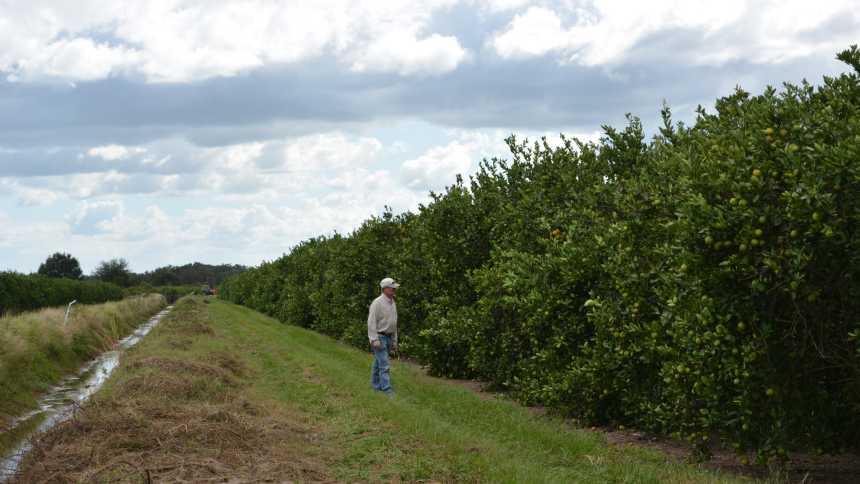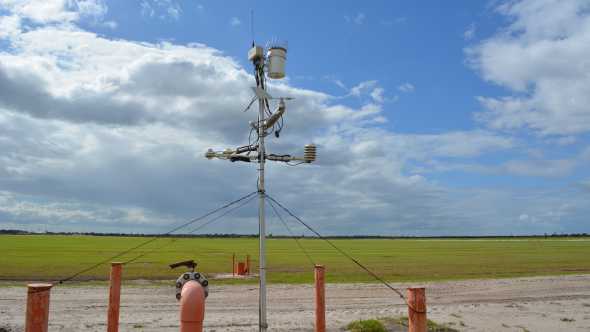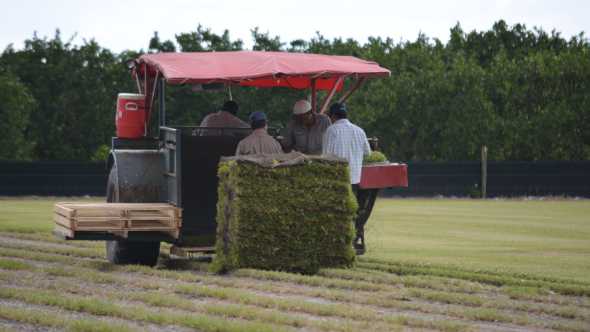Technology, Turf Experience Moving The Needle For Bethel Farms’ Citrus Groves

Jonathan Brown, senior VP of production for Bethel Farms, inspects trees in his citrus grove. Photo by Frank Giles
Seventh-generation Floridian Jonathan Brown grew up steeped in the state’s key agriculture sectors including citrus and cattle. And, for the past 18 years, Brown has worked as senior vice president of production for Bethel Farms based in Arcadia.
“Will Nugent, the owner and president of Bethel Farms, asked me to come work for them and manage their turf farm, which at the time was about 350 acres,” Brown says. “Since then, Will and his wife Kim, the daughter of the farm’s founder Walter Bethel, have given me the resources to grow and do things right, which makes things so much easier.”
The farm has grown in those 18 years with turf acreage at times growing as high as 4,000 acres. With partner growers, the turf operations have evolved into the Harmony brand, which is sold in sold in stores nationwide. In 1999, Bethel Farms added citrus to its portfolio at its Arcadia location.
Brown adds the past 18 years have seen a tremendous amount of change in Florida agriculture not the least of which is HLB and the threat it poses to the state’s signature crop. But, Brown keeps on the cutting edge of technology and best farming practices to stay ahead of the game. His crews gave him the nickname of “gadget man” reflecting Brown’s attraction toward technology.
“One of the first big innovations we brought to the farm about 10 years ago was the FarmWorks software,” Brown says. “The program was originally developed more for commodity crops, but I spent a lot of hours working with the program developers to adapt it to turf and citrus production. The program has allowed us to very specifically track our practices, timing, and costs. This shows us more precisely our successes to duplicate and our failures to avoid.”
The software allows for detailed recordkeeping of field operations, weather, fleet management, crop health, soil conditions, and irrigation performance.
Totally Wired
A few years ago, Bethel Farms was looking to grow its Arcadia farm without increasing its water usage.

Bethel Farms uses McCrometer CONNECT technology to wirelessly transmit data from across the farm.
Photo by Frank Giles
“We installed a tile system to save enough water to expand acres without increasing our consumptive use permits for groundwater,” Brown says. “Then we looked to the cost-share FARMS program from the Southwest Florida Water Management District and EQIP from USDA. We were looking to add a retention pond to recycle irrigation water and capture surface water. At the same time, I had been working diligently to put together a telemetry system that was user-friendly, functional, and affordable.”
In 2009, Brown installed the McCrometer CONNECT telemetry system. It tracks multiple points of reference with meters/probes for soil moisture, salinity, conductivity, daylight, soil and ambient temperature, wind speed and direction, and cold protection.
“We have these meters placed in different zones across the farm,” Brown says. “All of this data goes via radio cell to a server in our office. The server takes all the information and translates it into a report. Some of that data, like rainfall and irrigation cycles, we feed into the FarmWorks program.
“Between our irrigation improvements, retention pond, and telemetry system, we are reducing groundwater withdraws by 35%. We exceeded the groundwater offset goal set for our cost-share installation of the retention pound by 62%.”
The telemetry system also sends alerts for frosts, freezes, wind, and disease prediction. Brown says one event paid for the investment in the system when it predicted a rhizoctonia large patch outbreak in Empire Zoysia and sent out alert. In response, Brown was able to apply a protective, softer fungicide application. He left a couple acres control to test the alert.
“Within two weeks, the control looked like Martians had landed the large patch was so bad,” he says. “The protective application was about $100 per acre. It cost $300 per acre to clean up the control. That was a 158-acre field. Avoiding a $300 per acre across the entire field paid for the telemetry system investment.”
Brown uses the monitoring system to help in planning fertigation injections. He monitors the moisture levels in the soil profile to pick the optimum time to inject fertilizer, soil amendments, and/or fungicides.
“Where systemic insecticides like Movento (spirotetramat, Bayer CropScience) are concerned, I can utilize several readings from the telemetry system to push a foliar flush,” he says. “This allows us to time sprays accordingly for better psyllid control. The system also has alarms for wind and temperature. If the weather conditions go outside the programmed parameters, our operators receive an alert to stop until favorable operating conditions return.”
Knowledge Transfer
In addition to the vast amount of data collected through technology, Brown credits the education shared by others to the farm’s success.

Jonathan Brown of Bethel Farms is taking what he’s learned from turf production and applying it to growing citrus.
Photo by Frank Giles
“The bulk of things we are doing here is not because I am a good grower, it is because I am associated with some of the best growers in the world and have learned from them,” he says. “And they have taught me freely.”
Brown also is a willing cooperator in research trials with a host of suppliers and universities. In his research, he often looks for how practices can transfer between citrus and turf to the benefit of each crop. And, citrus certainly needed to benefit as production spiraled from the effects of HLB.
“We had blocks that were picking 600 and 700 boxes per acre that were down as low 140 boxes per acre,” he said. “Production just fell through the floor, yet I was spending more than I ever have on the input side.
“So, beginning in early 2013, I decided to take my turf program, which is all about growing roots and see what I could apply to growing citrus.”
During that same timeframe, Brown met the cofounders of Aqua-Yield at an international turf conference in Chicago. The company has developed a proprietary process that purifies water used in input applications. Next, the items being applied are “minified” or shaved down to much smaller sizes to make them more reactive. In the case of nutrients, the company says the combination of purified water and smaller particles makes for much more efficient applications.
“The purified water molecules are surrounding those [nutrition] particles, and it acts like a natural chelating agent,” Brown says. “The particles are small enough to be absorbed through the plant and a lot of them through the cell walls. It is in a mobile state and super efficient.”
Brown began testing the technology on turf in August 2013. He said, within a couple of weeks, they began seeing benefits from reduced inputs and increase vigor in plants. He implemented a trial on citrus to see if the benefits would transfer.
“We began seeing increased leaf size and caliper on resets,” Brown says. “We also observed trees that had not been responding to our [nutrition program] begin to respond with better vigor and less fruit drop.”
From 2013 to 2015, Brown reports increasing boxes and pounds in his grove, while reducing inputs.
“We have seen yield increases since applying the Aqua-Yield technology,” he says. “Some increases as high as 32% and the lowest yield increase was 14%,” he says. “Input cost reductions have been consistently in the 15% range, with some as high as 20%. We have some blocks I hope will go 400 boxes this season.”
Brown noted the program works with existing nutrition programs whether foliar or through the roots with fertigation.
“We have lots of data and currently have six university trials ongoing, but what we are observing is materials are as much as 10-fold more efficient going into the tree whether through the leaves or roots,” he says. “Where HLB is concerned, we tend to believe those smaller particles are able to escape the starchy phloem blocks caused by the disease. We are beginning to find materials applied to the roots showing up in the top of the tree.”
In addition, Brown is experimenting with a ribose-based material called C-15 designed to rebuild phloem in trees. But, he notes it must be combined with solid nutritional and cultural programs.
Because of its belief in the system, Bethel Farms has partnered with Aqua-Yield to act as its distributor in Florida.
“We certainly are not claiming a cure to HLB by any stretch, but we are back making a profit with citrus. Our trees are not where I want them to be, but where I could see five and six rows deep through canopies, now we have trees filling in beyond the earlier dieback. We just hope the trend will continue.”










